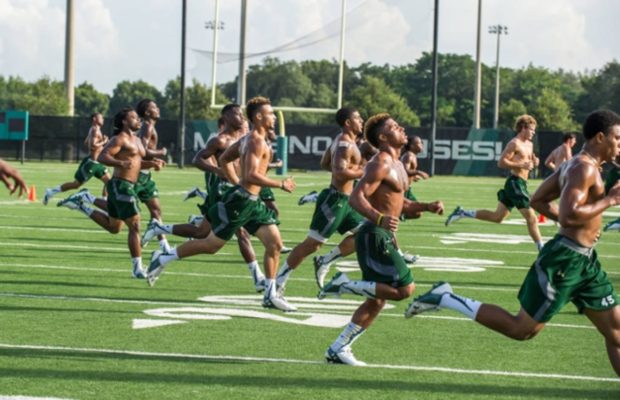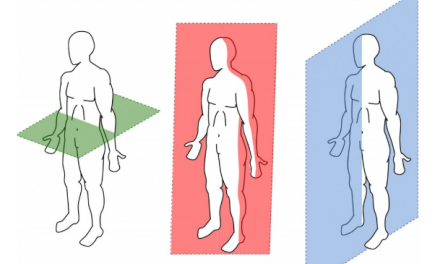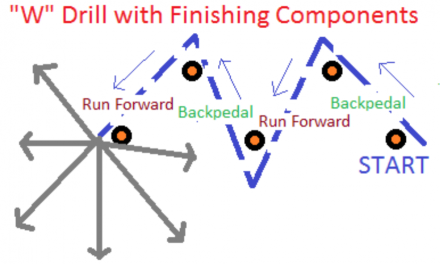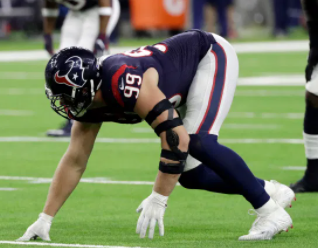Coaches constantly discuss the duration of a high school football game but they do not agree on how to measure it. Some coaches measure by the total number of plays, some by the number of plays multiplied by the average length of a play (in the NFL this is anywhere from 11 to 15 minutes total), some say the average high school game takes about 2-2.5 hours, while others say a game is 48 minutes long.
All of those measures are very logical, have an application to our in-game strategies, and should all be taken into consideration by all coaches.
From a conditioning perspective, I think through the game duration a slight bit differently:
- Most teams begin pregame activities an hour before the game starts.
- An average high school football game is around 2-2.5 hours.
- If a team or both teams throw the ball a lot or are up-tempo, the game time will be closer to 2.5 hours.
- For overtime games, the game will take around three hours.
- In extreme situations, Arkansas and Kentucky played almost a five hour game in 2003.
With all of those variables considered and training for worst-case scenarios, I think the following total game time formula would be:
(1 hour warm-up) + (2.5 hour game) + (30 minute overtime) = 4 hours
To show how important training for a four-hour game is, the NCAA made their overtime rules to keep games shorter. After the Arkansas v. Kentucky game, college football decided to start making teams attempt two-point conversions after the second overtime. Since then, the rule changed to require two-point conversions after the first overtime period. The NCAA did a study on injury prevention and realized as the game went on the chance for injury increased exponentially. Preparing for a four-hour game is not only important for winning each game but also will influence injury risk and recovery time.
The logical next question would be…How should we prepare for a four-hour game? There are a lot of ways to do this and coaches need to tailor their plan to fit within their program. The following conditioning ideas are easily implementable and can give your athletes an advantage.
CREATING AN IN-SEASON CALENDAR
In one of my previous articles, Build A Great Strength And Conditioning Program, I discussed how to build an in-season calendar and some of the questions that have to be answered. It is important to have an initial plan even if you change the plan along the way. Every plan will be changed at some point, to adjust to the needs of your athletes, and some years the changes will be greater than others.
It is important to note that it is hard to catch up on conditioning. If you realize your team is not conditioned properly after a playoff game, you cannot fix the problem since you should be in a taper phase. If you realize after a regular-season game that you do not have proficient conditioning, it is hard to quickly fix the problem unless your next two opponents are going to be easy wins. If you realize this after your first scrimmage, you will have a chance to fix the problem.
If you decide to start conditioning or add conditioning, but your players do not have a great conditioning base, you run the risk of tiring the players out so much that they will have “heavy legs” for your next opponent. You should add conditioning in slowly, unless your next opponent is an easy win, and understand that it will take a couple of weeks to improve the situation. Ideally, the off-season is where conditioning should occur and then the season should try to slightly improve it.
EASILY IMPLEMENTED CONDITIONING IDEAS
– Look at your weekly practice plans and calculate how much agility, linear speed, and conditioning each position group is performing. These amounts vary drastically across position groups just by the nature of the position. In most programs, Quarterbacks do no speed training during practice but that is all Wide Receivers do. If they are not doing very much, they will need to add those components to their individual drills or do extra work either before, during, or after practice.
– Condition at the beginning of practice. Teams need to learn how to practice all skills while tired. Almost every team does individual drills to start their practice but those drills are hardly ever practiced while tired. When I coached defensive backs I did not like that my players never did ball drills and high effort drills while tired. It is fair to argue that they would practice their skills during team and group periods but the intensity level was never as hard as the individual periods. We always did conditioning at the end of practice so we missed out on teaching the body to perfect their technique and practice skills while tired. A lot of defensive units accomplish this by doing “pursuit drill” at the beginning of practice but most offensive units do not do anything to this effect.
– Condition in the middle of practice for the same reasons above. To make this extremely efficient, add conditioning to the middle of a circuit or a drill because then you can put the players right back into the drill without any teaching, explanations, or new transitions. The players will then have to just go right back to where they were, without a break, and it is very hard on them both physically and mentally. Defensive units could do their “pursuit drills” during one of these periods.
– Condition at the end of practice. Athletes have to train and try hard when they are tired from practice. If the state championship game goes into overtime, you definitely want the players to be comfortable with running hard while tired.
- The following example is a weekly plan from one of my clients that shows how to schedule conditioning in different time slots:
– If your scout team is at a disadvantage (almost every team’s scout team is not good because it is made up of young players), you can condition your first and second team players before a particular period to try to even the playing field. One way to accomplish this is to run a couple of gassers with the first and second team players while the scout team players watch. As soon as they are finished running, they immediately start the team period so the scout team has a chance of succeeding.
Using this training method ended up leading to another positive unintended consequence. Normally on the first Friday night scrimmage, our players would seem to be gassed in the second quarter. I realized later it was because they had been playing against the scout team and they were now playing other varsity players that could actually fight back. My players were tired because their exertion level was so much higher than in practice but this conditioning philosophy remedied our problem in successive years.
DEFENSES PRACTICE UP-TEMPO ALL SEASON LONG
If you are an up-tempo offensive team, you are already doing this because your offense practices fast and as a result your defense has to practice fast also. If you are not an up-tempo offensive team, the defense still needs to practice up-tempo throughout the season because a defense cannot get ready in one week for an up-tempo offense. I know that there are ways to get the scout team to simulate an up-tempo offense by doing things like using two scout teams but that does not fix the lack of adaptation of an athlete’s heart and lungs. The players’ hearts and lungs cannot get ready in one week so they need to work on it all season and preferably all off-season too.
One year we played a team that did not prepare for our up-tempo offense. They did not send scouts and just saw the cut-up film so they did not know how fast we went. We motioned every play and still snapped the ball every 10 to 15 seconds. By the middle of the second quarter, they were so tired they could not get lined up and we were snapping the ball before they were set. Here is a snapshot of a play from that game.
There are advantages to this and also understand that when teams like Oregon first implemented their up-tempo offense, even the college coaches struggled to prepare their players. The following quote came from Lane Kiffin when he was at USC and was asked about his thoughts on preparing his team for Oregon over his bye week and the game week:
One way to prepare the defense’s hearts and lungs is by doing a “Metabolic Run”. In the following routine, the plan prepares the athletes for an up-tempo 10 play drive. The most important part of the drill is to only give players 10-15 seconds rest between each distance and then 2.5 minutes rest between each segment to simulate each play and then a possession change. To make it easy on the players to know how far to run next, I would stand where they had to run through, then run to the next spot before I blew the whistle again.
To make this conditioning concept even easier, you can also just run a particular distance over and over again. For example, you could do 30-yard sprints with 10 seconds rest between each. I like doing the different distances and especially some of the longer distances so the players really have to open up their legs.
CONCLUSION
The above ideas are just some that you can implement and if you already have some conditioning methods and concepts that are working for your program do not scrap it just because you see another coach doing it differently. Every plan needs some tweaks though and I am constantly learning new training methods and ways to implement those methods so my plans are an ever-evolving process. That being said, I have some non-negotiables in my programs that will always be a part of our program because they have stood the test of time.
If you are interested in learning more you can go to the resources page on my website (https://exceleratead.com/training-theory) to find my FREE and moderately priced CoachTube Courses, Coaches Choice Videos, and a variety of other training articles and resources. My contact information is on my website so please feel free to email me with any questions
Adam Szabo
Owner, Excelerate Athletic Development, LLC





